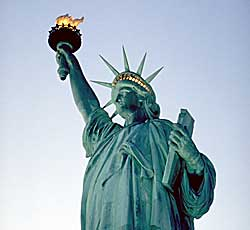 |
LITR 5731 Seminar in
Multicultural Literature American Immigrant Literature |
 |
Part I
How I came to this topic
v
American Minority Literature course
o
Bless Me, Ultima
o
Woman Hollering Creek
v
Independent Study
o
Finding other texts for the classroom
o
Class presentation
Teaching Mexican-American
Literature
(see Objective 5)
·
Why incorporate it in the
classroom?
Education is deeply implicated in the politics of culture. The curriculum is
never simply a neutral assemblage of knowledge, somehow appearing in the texts
and classrooms of a nation. It is always part of a selective tradition[.] . . .
[T]he decision to define some groups’ knowledge as the most legitimate, as
official knowledge, while other groups’ knowledge hardly sees the light of day,
says
something extremely important about who has power in society. (Apple 1996, p. 22
qtd in Vasquez)
·
What can be gained by
incorporating it?
“... ‘multi-directional cross-cultural acculturation’ was taking place in the
classroom as students learnt about the Chicano culture in an educational space
that did not uphold white, middle class American values as the pinnacle of
achievement.” (Vasquez 919)
·
What makes a “good” text?
o
Emic constructs: things
expressed in terms that are meaningful to native members of a culture
o
Etic constructs: things
expressed in terms that are meaningful to outside observers of a culture
Example:
“…many books seemingly affirm a Hispanic perspective, such as through the
sporadic use of Spanish terms or names, but the frequent use of stereotypes does
not inspire the development of a critical perspective. The interpretation of
Latinos in multicultural literature sometimes accommodates the popular
discourses of predominantly white readers…” (Godina, McCoy 174)
Lists of Popular Texts
·
Frankson, Mary Stewart.
“Chicano Literature for Young Adults: An Annotated Bibliography.”
The English Journal, 79.1 (1990):
30-38. National Council of Teachers of
English. JSTOR. Web. 14 June 2010.
(Stable URL: http://www.jstor.org/stable/818901)
·
University of New Mexico
PhD Reading List for Chicano/a Literature
http://www.unm.edu/~english/resources/documents/pdf/Chicano-a%20Literature.pdf
Questions to Consider
1.
Can Mexican-American
literature fit into the category of immigrant literature? If yes, give examples
of how it follows the course objectives and formula you’ve seen in previous
readings. If not, what is it, and is it possible to categorize at all?
2. Does it have a place in the literary canon,
-
i.e. being taught in more “mainstream” classes like Forms of Literature or American Literature, or
-
should it remain to in “multicultural” classes like Immigrant Literature or Minority Literature?
3.
What is your experience studying Rudolfo Anaya (Bless Me, Ultima),
Richard Rodriguez (Hunger of Memory), and Sandra Cisneros (The House
on Mango Street)—texts that often constitute the Mexican American "canon" in
the USA's literary curriculum?
4.
What strengths and limits to this canon?
5.
How do today's texts reinforce or diversify that canon?
![]()
Part II
Short stories
“Last of the Menu Girls”
Ø
The story portrays a wide
range of Mexicans in America—new immigrants, those who straddle the line between
the two cultures, and the fully assimilated, as well as illegal and legal
immigrants. What attitudes do the members of these groups have towards each
other? What about the Anglos—where do they fall? What about Rocio?
Ø
How do Rocio’s experiences
stack up to other immigrant narratives you’ve read this semester? Was it a case
of “same story, different names” or was it unique in some way?
Ø
Adolescents seem to crop up
often in immigrant narratives. Why is this so common? Consider possible
parallels between coming of age narratives and immigrant narratives (see
Objective 2c).
o
Cielito Lindo YouTube
Video; translation of
lyrics; Why is this song mentioned three times
through the story?
“Romero’s Shirt”
Ø
The allure of the American
Dream figures prominently into this story. How has harboring this ideal affected
Romero? Consider the Langston Hughes poem “A
Dream Deferred” and how this might relate to
Romero; also Objective 3.
Ø
What is the significance of
Romero’s shirt, both to him and to the story?
Ø
Ambiguous ending—does
anything change for Romero?
Poems
“La Tere Smelled of Fish”
“Poema para los Californios Muertos”
Works Cited and Consulted
Godina, Heriberto, and Rachelle McCoy. "Emic and etic
perspectives on Chicana and Chicano multicultural literature." Journal of
Adolescent & Adult Literacy 44.2 (2000): 172. Education Research Complete.
EBSCO. Web. 21 May 2010.
Vasquez, Jessica. "Ethnic identity and Chicano literature:
How ethnicity affects reading and reading affects ethnic consciousness."
Ethnic & Racial Studies 28.5 (2005): 903-924. Academic Search Complete.
EBSCO. Web. 24 May 2010.
Leal, Luis. "Into the labyrinth: Chicano literature in search
of a theory." Aztlan 22.2 (1997): 107. Academic Search Complete.
EBSCO. Web. 24 May 2010.
Martin-Rodriguez, Manuel M. "'A Net Made of Holes': Toward a
Cultural History of Chicano Literature." 1. Duke University Press, 2001.
Education Research Complete. EBSCO. Web. 21 May 2010.
Chavez, Denise. The
Last of the Menu Girls. New York: Vintage Contemporaries, 2004.
Gilb, Dagoberto. The
Magic of Blood. Albuquerque: University of New Mexico Press, 1993.
Urrea, Luis Alberto.
The Fever of Being. Albuquerque: West End Press, 1994.
Ramazani, Jahan and Richard Ellmann (eds).
The Norton Anthology of Modern and
Contemporary Poetry, Volume 2. New York: W.W. Norton & Company, 2003.
